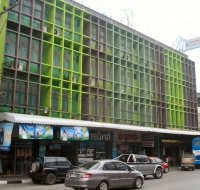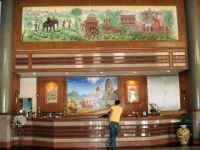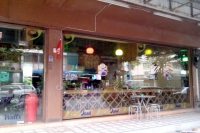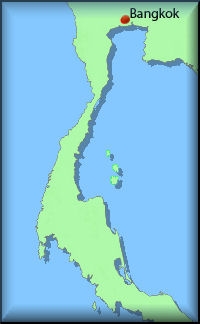 |
Ratchaburi
Hotel >>
Araya Hotel (อารยะ) (Ratchaburi) 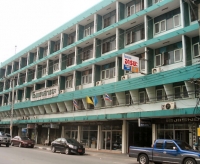 Das Araya Hotel ist ein typisches chinesisches Hotel im Stadtzentrum. Es verfuegt nur ueber 12 Zimmer in einem vierstoeckigen, grossen Stadtgebaeude. Die grossen, sauberen Zimmer haben Ventilator oder Klimaanlage, einige auch Warmwasserdusche. Mit dem Lift gelangt man in den 4. Stock. Das Araya Hotel ist ein typisches chinesisches Hotel im Stadtzentrum. Es verfuegt nur ueber 12 Zimmer in einem vierstoeckigen, grossen Stadtgebaeude. Die grossen, sauberen Zimmer haben Ventilator oder Klimaanlage, einige auch Warmwasserdusche. Mit dem Lift gelangt man in den 4. Stock. 187/1-12 Kraipet Road, Na Muang, Ratchaburi 70000 Tel.: 032-337781 oder 032-337782 - Fax.: 032-338022 Hotel >>
When you have your own transport these two hotels are an option
Hotel >>
Western Grand Hotel (โรงแรม เวสเทิร์นแกรนด์) (Ratchaburi) 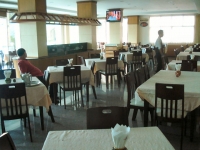 105/1 Old Petchkasem Road, Na Mueang, Ratchaburi 70000 Tel.: 032-337777 oder 032-313888 - Fax.: 032-320123 Hotel >>
Bakery >>
Museum >>
Ratchaburi National Museum (พิพิธภัณฑสถานแห่งชาติราชบุรี) (Ratchaburi) The style of architecture of the National Museum, Ratchaburi is contemporary to the one at the National Museum, Ubon Rachthani because both were used as the city halls in the same period. Also, both are presented in the same context, that is, as city museums that tell about the history and culture of the province. The building in Ratchaburi was built during the reign of King Rama VI in 1922. The buildings are laid out in a rectangular structural plan with one building standing in the middle. Empty spaces on the left and the right of this building are used for gardens. It is constructed of bricks, covered with plaster. The floor is elevated from the ground level, and made of fine teak weed. A distinguishing characteristic is the porch entrance. The roof appears in hip-roofed style. Its pediment is constructed in a stucco arch, decorated with a statue of a garuda, above which the name “Ratchaburi City Hall” is inscribed. Next to the museum, there is a building which used to be the government headquarters of the precinct, and is situated in the same compound. It is believed to be built before 1873 to be a residence of Somdet Chao Phraya Borom Maha Si Suriyawong (Chuang Bunnag), the regent during the early period of King Rama V’s reign, and before the conversion to the government headquarters of the precinct. The exhibition’s theme is to describe the life of Ratchaburi people living along the Mae Klong River. As the story unfolds, it is supported by using ancient art and artifacts as evidence to tell its importance from the past to present, shedding light on various societies, both economically and politically, as lifestyles changed over time. Presentation begins with the traces of settlements of prehistoric men in Ratchaburi at the period of twelve thousand years ago. Indications from the evidence show that human settlements areas are along the plateau and the alluvial plain areas. Afterwards the settlements developed into agricultural societies, as was seen in Khok Phlap village of Phohak sub district, district of Bang Phae. Here, archaeological finds proved that men were already familiar with the use of metal. Aside from utensils such as pottery, stone, bronze and iron tools, there are traces of human activities from settlements on a shoreline, suggested by shells and other ornaments made of resources from the sea. These findings seem logical because the actual geological condition of Ratchaburi three thousand years ago was when this area was part of the Gulf of Thailand. From prehistory, the exhibition moves on to the trade relationships between the people of this region and countries like India and China. From as early as the first century A.D., trade exchange rendered a good economy to these communities, especially to the port cities like the city of Ratchaburi. Proof of this prosperity can be seen indirectly form the traces of Dvaravati culture, the great empire which influenced many cities in the central part of the country. One major example is the ancient city of Khu Bua, where remains of a rectangular shape of the city plan show it was surrounded with one layer of a moat and two layers of earthen ramparts. The outline of the city was situated on a natural mound which is typical of Dvaravati cities and monuments found in the area. Many stupas, of both sects of Buddhisn, Hinayana and Mahayan, were found. Most important are the attractively decorated statues made of terra cotta and stucco, found at the monuments. They were figures of Bodhisattvas, Buddha images, deities, human forms, dwarfs and animals. Many votive tablets were also discovered; some were inscribed with a sacred creed, called “Ye Dhamma” in the Pali language. Among the finds at Khu Bua was some “Dhamma Chakra” or “the Wheel of Doctrine,” which are important symbols of Buddhism. |
Neu bei t-Globe?
Bitte anmelden, um diese Webseite voll zu nutzen!
Registrierte Mitglieder koennen: |
||||||||||||||||||||||||||||||||||||||||||
|
|


